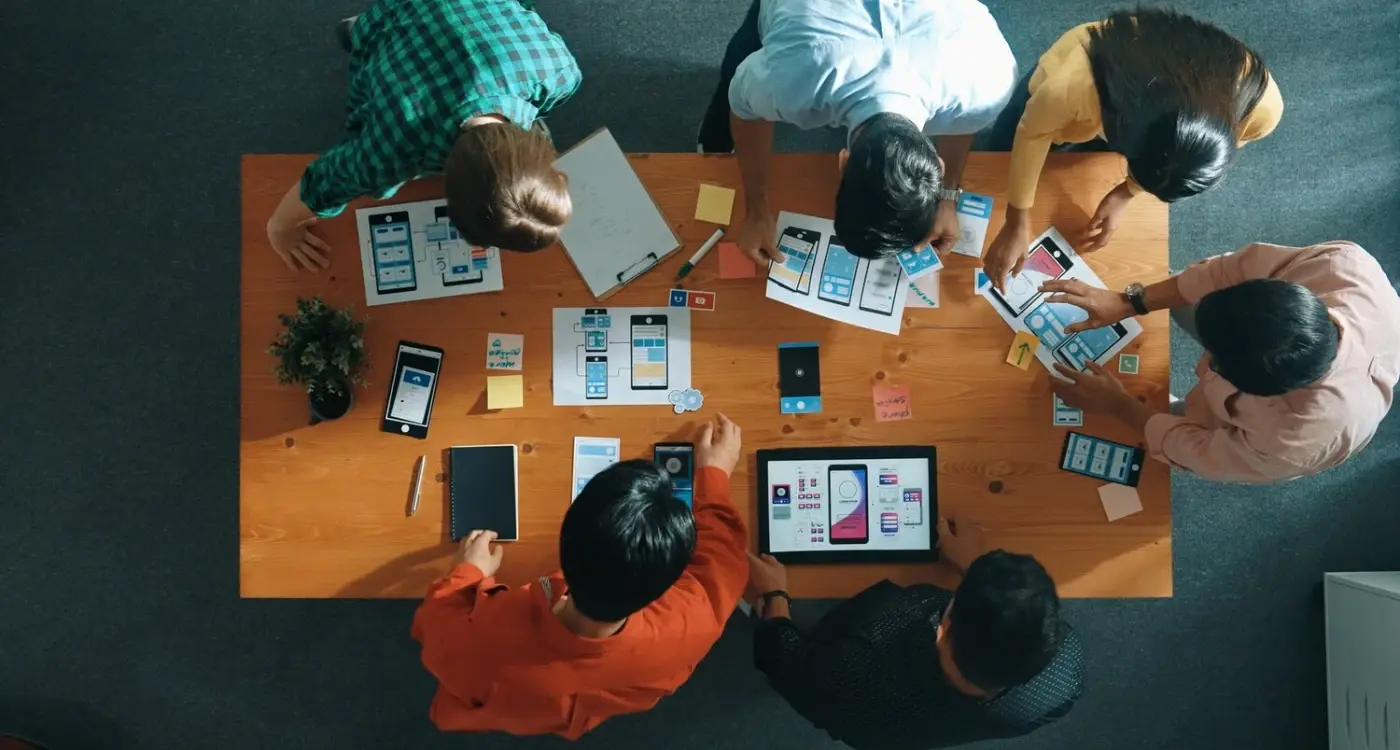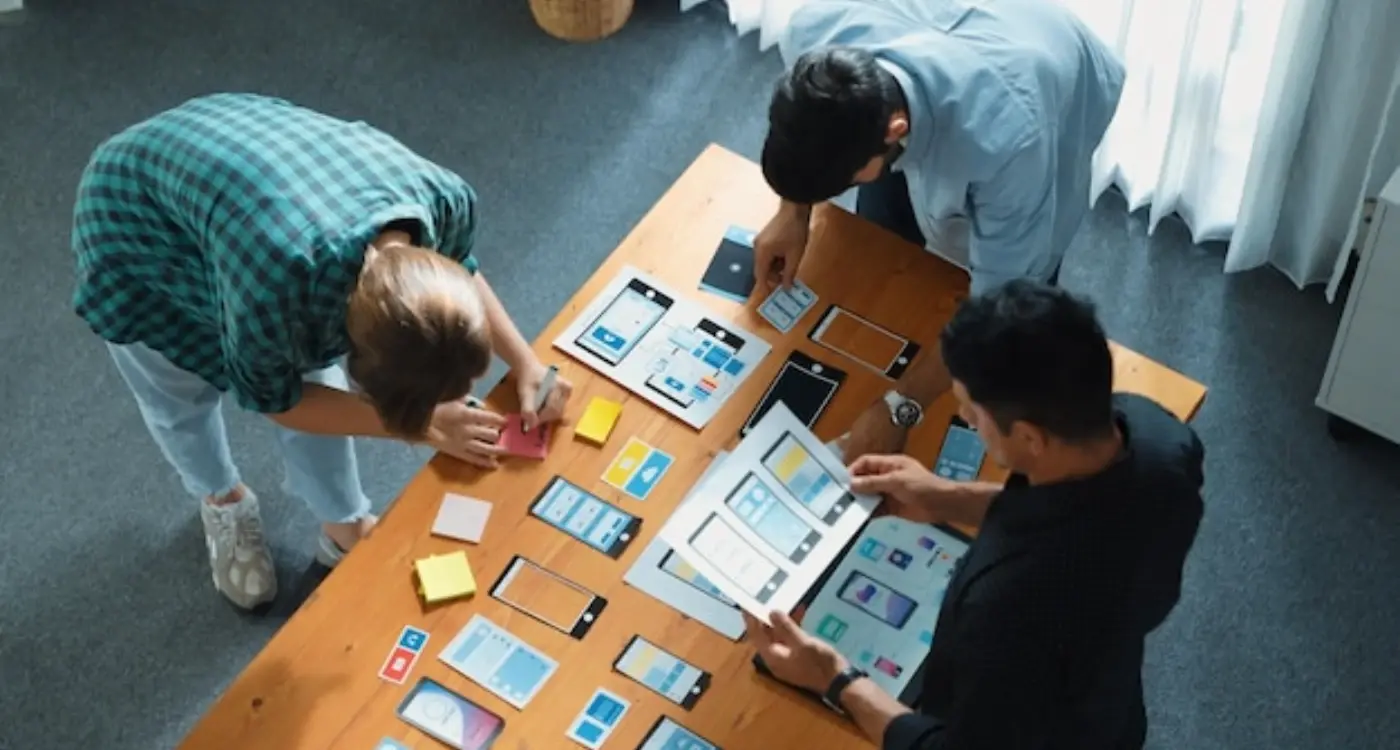How Many Developers Are Needed to Make an App?
So you've got this brilliant app idea bouncing around in your head and you're wondering how many people you'll need to bring it to life. I get this question almost every week from clients—and honestly, it's one of the trickiest to answer! The truth is, there's no magic number that works for every project. Some apps can be built by a single developer working evenings and weekends, whilst others need entire teams of specialists working for months.
After building apps for over eight years, I've seen teams of all shapes and sizes tackle everything from simple productivity tools to complex social platforms. What I've learned is that app development team size depends on so many factors—your budget, timeline, the complexity of your idea, and what kind of experience you want to create for users. Getting your development team structure right from the start can make or break your project.
The biggest mistake I see is either trying to build with too few people and burning out, or hiring too many developers and watching costs spiral out of control
This guide will walk you through the different mobile app development resources you might need, from solo developers to full-scale teams. We'll look at real examples and help you figure out the right mobile dev team for your specific project—without all the confusing jargon that usually comes with these conversations.
Understanding App Development Team Basics
When I first started building apps, I thought all I needed was one brilliant developer who could code everything. Boy, was I wrong! Building a mobile app is like constructing a house—you need different specialists for different jobs. You wouldn't ask a plumber to wire your electricity, would you?
Core Team Members
At the heart of every app project, you'll find a few key players. There's the frontend developer who builds what users see and touch on their screens; the backend developer who handles all the behind-the-scenes magic like databases and servers; and often a designer who makes everything look beautiful and work smoothly. These three roles form the foundation of most app teams.
Team Size Depends on Your App
Here's what I've learned after years in this business—there's no magic number for team size. A simple calculator app might only need one or two developers working part-time for a few weeks. But a social media platform? That could require ten or more people working for months. The complexity of your app idea directly affects how many hands you'll need on deck.
The key is matching your team size to your app's ambitions, not the other way around.
Simple Apps and Small Teams
When I tell people they can build a basic app with just two or three developers, they often look at me like I've lost my mind. But it's true! Simple apps—think calculators, basic to-do lists, or straightforward information apps—don't need massive development teams. You'd be surprised how much a small, focused group can achieve.
For most simple mobile apps, your core app development team size should include one iOS developer, one Android developer, and ideally a backend developer if your app needs to store data online. That's it. Three people can create something brilliant when they know what they're doing. Of course, you might also want a designer, but many small teams share responsibilities—developers often handle basic UI work while the backend person doubles up on project management.
What Makes an App 'Simple'?
Simple apps typically have these characteristics:
- Limited number of screens (usually under 10)
- Basic user interactions like tapping and swiping
- Minimal data storage requirements
- No complex integrations with other services
- Straightforward user journey from start to finish
Start small and scale your mobile dev team as your app grows. Many successful apps began with tiny teams—Instagram famously started with just two people!
The beauty of small teams is speed and communication. Everyone knows what everyone else is doing, decisions get made quickly, and there's no bureaucracy slowing things down. Your mobile app development resources stay lean, your budget stays manageable, and you can actually ship something without endless meetings about who's responsible for what.
Medium-Sized Apps and Growing Teams
Now we're getting into interesting territory—apps that do more than just the basics. I'm talking about social media platforms, e-commerce apps, or productivity tools that actually make people's lives easier. These aren't your simple calculator apps; they need proper backends, user accounts, push notifications, and often integrate with other services.
For medium-sized apps, you'll typically need between 4-8 developers. This is where things start getting serious and you can't just wing it with a couple of people anymore. The workload becomes too much for a tiny team, and frankly, you need different brains tackling different problems.
Your Core Team Structure
Here's what I usually recommend for medium-sized projects:
- 2-3 mobile developers (iOS and Android specialists)
- 1-2 backend developers for server-side magic
- 1 UI/UX designer who actually knows what they're doing
- 1 project manager to keep everyone sane
- 1 QA tester (trust me, you need this)
The beauty of medium-sized teams is that people can still wear multiple hats when needed, but everyone has their main expertise. You get the benefit of specialisation without the overhead of massive teams. Development time usually sits around 4-8 months, depending on complexity and how many times you change your mind about features!
Complex Apps and Larger Teams
When you're building something like a banking app, social media platform, or enterprise software, you're looking at a completely different beast. These complex apps need serious horsepower—we're talking about app development team sizes of 15 to 30+ people, sometimes even more depending on the scope. I've worked on projects where we had separate teams just for security, payment processing, and backend infrastructure.
Core Team Structure
Your mobile app development resources need to be spread across multiple specialisms. You'll typically need several iOS and Android developers, a handful of backend engineers, dedicated DevOps specialists, security experts, and QA testers. Don't forget about the UI/UX team—they become even more critical when you're managing complex user journeys across different user types.
The biggest mistake I see companies make is underestimating how much coordination a large development team structure requires
Managing the Complexity
App development staffing at this level means you need proper project management, scrum masters, and team leads. The technical challenges multiply exponentially; you're dealing with microservices, API integrations, real-time data processing, and scalability concerns. Your app project team requirements will include people who can architect these systems properly from day one. Trust me, trying to retrofit scalability later is a nightmare you want to avoid.
Specialist Roles You Might Need
Right, so you've got your core team sorted—developers, designers, maybe a project manager. But here's where things get interesting. Depending on what your app actually does, you might need some specialists that most people don't think about until they're knee-deep in development.
Security and Compliance Experts
If you're handling payments, personal data, or anything remotely sensitive, you'll want someone who knows their stuff about security. I've seen too many apps get knocked back during review because they didn't think about data protection properly. Payment apps need PCI compliance experts; healthcare apps need HIPAA specialists. These aren't nice-to-haves—they're must-haves.
Platform-Specific Specialists
Sometimes you need people who live and breathe specific technologies. Here's what I mean:
- AR/VR developers for immersive experiences
- Machine learning engineers for AI features
- Blockchain developers for crypto functionality
- IoT specialists for connected device integration
- Accessibility experts for inclusive design
The thing is, these specialists often work on a contract basis rather than full-time. You bring them in when you need them, get the job done, then they move on. It's more cost-effective than keeping them on payroll, and frankly, most projects don't need them for the entire development cycle.
Budget and Timeline Considerations
Here's the reality nobody wants to talk about—your app development team size will be heavily influenced by how much money you have and when you need it finished. I've seen countless projects where clients want a team of ten developers but have the budget for two. It doesn't work that way, and pretending it does only leads to frustration.
Your mobile app development resources need to match your financial reality. A larger development team structure means higher monthly costs, but it can also mean faster delivery. Smaller app development team sizes take longer but cost less upfront. The trick is finding the sweet spot where your app development staffing makes sense for both your wallet and your deadlines.
Timeline Reality Check
If you need your app yesterday, throwing more developers at it won't always help. Adding people to a late project often makes it later—too many cooks and all that. Your mobile dev team needs time to coordinate, communicate, and actually build something worthwhile.
Budget Flexibility
Smart clients build in a buffer of about 20% for their app project team requirements. Things change, features get added, and complexity grows. Having that financial breathing room means you can adjust your team size when needed without panic.
Start with your minimum viable team and scale up gradually rather than hiring everyone at once—it's easier on your budget and often more effective.
Finding the Right Team Size
Right, so you've looked at all the different team sizes and roles—now comes the tricky bit. How do you actually figure out what's right for your project? After building apps for years, I can tell you there's no magic formula that works every time. But there are some smart ways to work it out.
Start with Your Must-Haves
First things first: make a list of what your app absolutely must do. Not the nice-to-haves or the wouldn't-it-be-cool features—just the core stuff that makes your app work. This will give you a good sense of complexity and help you understand the skills you'll need on your team.
Consider Your Timeline and Budget Reality
Here's where it gets real. You might want a team of eight developers, but if your budget only stretches to three, that's your answer right there. Same goes for timelines—adding more people doesn't always mean faster delivery; sometimes it just means more coordination headaches.
| App Type | Recommended Team Size | Timeline |
|---|---|---|
| Simple utility app | 2-3 people | 2-4 months |
| Social or e-commerce app | 4-6 people | 4-8 months |
| Complex enterprise app | 6+ people | 8+ months |
My advice? Start lean and grow your team as you need to. It's much easier to add people than to manage a team that's too big from day one.
Conclusion
After eight years of putting together mobile app development teams, I can tell you that there's no magic number when it comes to app development team size. What I've learned is that the right team depends entirely on what you're building and when you need it finished. A simple productivity app might only need two or three developers, whilst a complex social platform could require fifteen people or more.
The key thing I always tell clients is this—start small and grow your team as needed. You don't need to hire everyone at once. Begin with your core developers and add specialists like UI designers or backend engineers when your app demands it. This approach keeps costs manageable and lets you adjust your mobile dev team as the project evolves.
Getting your app development staffing right isn't just about counting heads; it's about finding people who work well together and understand your vision. I've seen projects with massive teams fail because they lacked clear communication, and I've watched small, tight-knit groups create brilliant apps that millions of people love.
Your development team structure should match your app's complexity, timeline, and budget. Trust me—spend time getting this balance right, and you'll save yourself months of headaches later on.
Share this
Subscribe To Our Learning Centre
You May Also Like
These Related Guides

Do I Need a Separate Team to Build Wearable Apps?

Who Are the Key People You Need on Your App Team?



